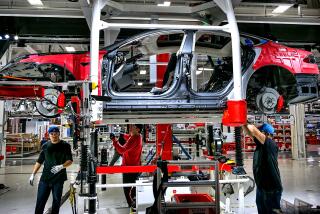GloboCars: THE NEXT CENTURY : Latin American Producers Put Pedals to Metal : No country in the region has a mass market yet. But the auto industry is booming as never before.
- Share via
BUENOS AIRES — Abram Boczkowski wanted a new car, so he joined “the plan,” a national sales lottery, hoping that his number--and his car--would come up in the monthly drawing.
Just for the opportunity to buy, he had to pledge to make monthly payments of $300 for five years. And if his number didn’t come up, he’d still have to keep making them.
Lottery systems such as Argentina’s remain a popular way to buy a car in a region where demand outruns supply and often-rampant inflation has discouraged long-term loans typical in the United States and elsewhere.
Boczkowski was not lucky.
“I waited 15 months and didn’t win the draw,” said the 67-year-old accountant with sparse gray hair and wire-rimmed glasses.
So he opted for the monthly bid, another variation on the plan.
Bidders offer to pay, in a lump sum, any number of their monthly payments.
“I offered $8,000 for them to deliver the car to me,” Boczkowski said. “If someone else offered $9,000, the car would be delivered to him.”
But Boczkowski’s turned out to be the winning bid. Now he was in the paperwork department of the Serra Lima auto agency, making his payment and filling out forms.
Whether through “the plan” or standard purchase programs such as bank loans, now increasingly available as inflation subsides, Argentines and other Latin Americans are buying more cars, boosting the importance and potential of the automobile in this region of 450 million people.
While economic development and living standards have yet to reach levels that would give any Latin American country a mass market, the automobile industry is booming as never before.
Last year, Brazilian and Argentine manufacturers produced record numbers of vehicles. Mexico had a record 1992.
Volkswagen, Ford, General Motors and Fiat manufacture complete cars in Brazil. Ford, VW, Renault, Fiat and Peugeot do so in Argentina. In Mexico it’s Ford, GM, Chrysler, Nissan and VW. In some other Latin American countries, including Chile, multinational companies assemble cars from imported components.
Trade barriers have been lowered, opening the door to more imports and exports. With free-market reforms and less customs protection, Latin American auto industries have had to become more competitive, and many car prices have been reduced. Bank credit is more accessible to buyers.
If prices keep dropping, and purchasing power keeps rising, automotive analysts foresee years of expansion in manufacturing and sales.
Here is a brief survey of Latin America’s Big Three auto markets:
* In 1987, when Latin American economies were slogging through a deep slump, Brazil’s vehicle production (cars, trucks and buses) plunged to barely 600,000 a year, about half the historic peak of the late 1970s. All Brazilian car makers were hit hard, and the two largest joined forces to survive. In both Brazil and Argentina, the manufacturing subsidiaries of Ford and Volkswagen merged to form a new automotive giant, Autolatina.
Autolatina went through a bumper-to-bumper overhaul--scaling down staffs, renewing machinery and unifying assembly processes. Its current work force--47,000 in Brazil and 7,000 in Argentina--is 30% thinner than seven years ago.
Last year, the slump seemed like distant history. Brazil produced a record 1.4 million vehicles (Autolatina 550,000). Exports ran more than 20% of total automotive output. Brazilian manufacturers say their early reports show 1993 production will put Brazil in 10th place among world auto makers, up from 14th in the mid-1980s and ahead of Italy and Mexico. By the year 2000, industry leaders predict, they will sell 2 million units.
Free-market reforms since 1990 have pried open Brazil’s closed economy, lifting bans on imported cars and gradually reducing duties. Competition has forced all companies to begin voluntary retirement programs to reduce the labor force. Industry employment has been slashed from 158,000 in 1986 to 119,500.
Brazil is a long way from putting a car in every garage. This country of 150 million people has about 15 million vehicles, including buses and trucks. But even that number has created severe environmental problems. Greater Sao Paulo, the only Brazilian city where atmospheric pollution is systematically measured, has 3.5 million cars for 16.5 million inhabitants--and a sky blackened with exhaust.
Belatedly, Brazil began introducing pollution-control methods in 1988, concentrating on the engines and exhaust systems of light vehicles, which contribute 80% of the carbon monoxide emissions. By 1997, if further planned controls are implemented, Brazil will achieve the U.S. standards in force in 1983.
* Mexico’s industry is rapidly moving from a domestic to a hemispheric focus. Auto makers are refitting their old plants around Mexico City to make them more competitive by international standards.
By 1984, Mexico was making 2.4 million engines a year--most of them for export, because the country produced only 357,000 finished vehicles. Soon afterward, companies built modern assembly plants near the U.S. border to manufacture cars for export.
Today, autos are second only to oil in Mexican industry, accounting for 2.4% of the gross domestic product and 9.6% of manufacturing. About 457,000 Mexicans, one of every seven factory workers, are employed in some phase of auto making.
Last year, auto makers were allowed to import fully assembled foreign cars for the first time in three decades, and that opening will continue under the North American Free Trade Agreement, which went into effect Jan. 1. By 1998, Mexico will be required to lift all restrictions on imports of new cars made in North America, and by 2019 all North American used cars must be allowed into the country as well.
Auto makers are already producing for a unified North American market by shifting production among plants in the United States, Canada and Mexico.
Mexico’s domestic auto sales reached a record high in 1992. The 1993 recession, combined with tougher tax rules for company cars, put a damper on sales, but some middle-class consumers are still able to buy economical, compact models that sell for about 10% to 30% more than U.S. retail.
The Volkswagen Beetle is still king of the road in Mexico, not only because of the low price but also for the company’s creative financing schemes. VW runs a lottery like the plan in Argentina.
About 5 million automobiles in Mexico City are responsible for 70% of the metropolitan area’s choking air pollution. City-sponsored awareness campaigns encourage people to drive less, but overcrowded buses and subways are not appealing alternatives.
* When the government opened the Argentine market to auto imports, local auto makers groaned. “We weren’t accustomed to competition,” said Rodolfo Ceretti, a longtime Ford executive. “Now we are getting accustomed.”
One in every four cars bought by Argentines today is an import. “It’s a threat, but it is a challenge to be efficient,” Ceretti said.
Indeed, Argentina’s total vehicle production--including cars, trucks, utility vehicles and buses--rose from 99,600 in 1990, in the depths of a long economic crisis, to a record 342,000 in 1993.
Argentina, with a population of 33 million, is the smallest Latin American country with a full-scale auto industry. One strategy for efficiency has been mergers. Argentina’s Fiat and Peugeot manufacture jointly, as do Ford and VW in Autolatina, the Brazilian-Argentine joint venture.
General Motors, which left Argentina more than a decade ago, is coming back to join the Argentine subsidiary of Renault in the manufacture of pickups and is expected to get back into building cars.
That would give GM manufacturing interests in both Argentina and Brazil, something that Ford, VW and Fiat already have--a cross-border presence. By combining to produce for both markets, car plants on both sides of the border cut costs by producing vehicles in larger quantities.
Mercosur, an economic integration project scheduled to take full effect at the end of this year, will combine the markets of Argentina, Brazil, Uruguay and Paraguay. “With integration with Brazil, it has become necessary for all companies there or here to be on both sides,” said Dasso of the Assn. of Automotive Factories.
Argentine auto makers are also reaching for a piece of the global market. Argentine-made Uno motors, for example, are exported to Fiat in Italy. Argentina’s total automotive exports were valued at $800 million in 1993, up from $167 million in 1990.
The national market is also expected to keep growing. With 6 million cars in the country, industry planners calculate that a 10-year replacement cycle will require 600,000 new cars a year, 258,000 more than the record production of 1993.
Growth will add to urban air pollution, but breezy Buenos Aires has natural defenses. Widespread use of natural gas as automobile fuel also helps. More than 250,000 vehicles, mostly taxis heavily concentrated in Buenos Aires, run on clean-burning gas.
*
Times staff writer Juanita Darling in Mexico City and special correspondent Mac Margolis in Rio de Janeiro contributed to this report.
Argentina’s motor-vehicle production (units)
1993: 342,350
Source: Argentina Assn. of Automotive Factories
More to Read
Sign up for Essential California
The most important California stories and recommendations in your inbox every morning.
You may occasionally receive promotional content from the Los Angeles Times.










